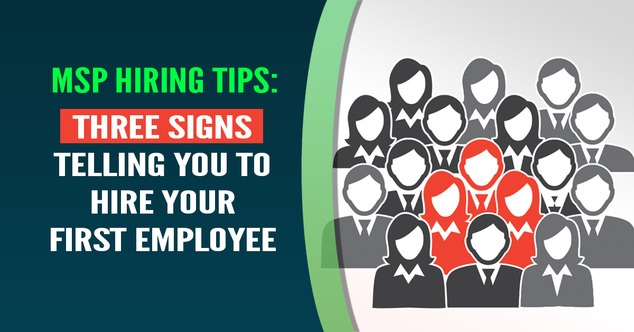- You are here:
- Home »
- Blog »
- MSP Management »
- MSP Hiring Tips – Three Signs Telling You To Hire Your First Employee

MSP Hiring Tips – Three Signs Telling You To Hire Your First Employee
As an entrepreneur, you look forward with optimism as your business continue to scale up. But it could also be a rough ride when you feel you have too much on your hands. And you no longer have enough time to be able to do all the things you need to do to run your business. This could leave you frustrated and exhausted. But there’s also the “to be, or not to be” dilemma. Should you hire an employee or not? Hiring help prematurely could put your business at risk for potential cash flow problems. On the other hand, it can bring in more growth for your business.
In this MSP hiring tips article, we will consider three major signs telling you it’s time to hire an employee.
When You Refuse More Work
Getting busy is a good indication that your business is growing. However, turning away potential clients is not really the best way to go on your startup. There may be appropriate times to turn away customers, but just not having enough time to accept work could cost you money in the long run.
It’s more expensive to acquire clients than to retain them. Think of what you need to spend to convince a potential customer to hire your services. Starting from your market research, to prospecting, to lead generation, to setting appointments, and finally closing the deal. This all cost a significant amount of your time and money. So turning away work from a good prospect is like throwing away your acquisition cost.
Also, the clients that you turn away will head to the competition and could form a lasting business relationship with them. In time, they may also bring in more customers to your competitor through referrals. In turning down work, you are inadvertently feeding new customers to your competition. This could result to your competitor becoming a “big fish” in the market while your business shrink into a corner.
So being too understaffed to handle the workload is a crucial indicator to hire your first employee.
When Complaints Are Increasing
Clients can complain about almost anything. And there’s nothing pleasant in handling complaints. But if you are receiving negative feedback, it’s still a good thing. Why? Because your customers haven’t left you yet. And you can still fix what’s wrong and keep their business. You should be quick to address the problem. It’s a way to show that you’re taking these complaints seriously. Otherwise, your customers will leave.
If customers are complaining about the quality of your work or how difficult it is to get on your schedule, it could mean you’re spread too thin. Negative feedback such as this can damage your reputation. In turn, poor customer service has an adverse effect on your revenue.
So for you to deliver your commitment to each client, you’ll want to hire additional help. Even if it’s just someone to answer your phone, emails, or keep your records and schedule organized. The goal is to have those extra free hours back so you can do your job with your best foot forward. And provide quality service.
When you are bombarded with customer complaints, consider this as a symptom that your business needs another helping hand.
When You Can Finally Afford It
When your business was just taking off, it may not have been able to give you the level of pay you wanted for yourself. And it may take a while before your business can gain a steady stream of income. If you’re planning to hire help, then you’ll want to make sure that your business can sustain this decision financially. Otherwise, this considerable amount of overhead cost can spell trouble for your business.
How can you tell if your new hire is in your budget?
One way is by estimating your future sales. You could check your monthly profits from the last few months and project out at least one year ahead. Include any pending deals that will likely close, and how many new customers this will bring in. While a lot of variables can still come into play, a sales forecast will tell you if you are ready to hire help or wait until things pick up.
Evaluating your profit margin can also help in your decision. You add the cost of your new employee to your overhead expenses. If you estimate that this will still turn a profit, then you can feel confident of hiring additional help.
Taking on staff will eat into your profit, but having a second person can potentially double your income. Its better to have 80% of $200,000, than 100% of $100,000.
If you’ve been experiencing losses for the last few months, hiring an employee may not be the best option. Other issues can also arise, so make sure that your profit margin and your cash on hand can cover the unexpected.
These three are just several of the signs for you to hire additional help. If you decide that you’re ready to hire an employee, you do have several options. You can hire someone for full-time or part-time work. You can hire a freelancer, a contractor, or hire temporary employees. The goal is to alleviate some of your burden and gain more time to take care of and grow your business. In our next MSP hiring tips article, we’ll talk about whether it’s more practical to hire a full-time employee or a contractor.
PS: If you are an MSP and are struggling to find time to market, check out our White-Label Newsletter service. It contains done-for-you newsletter content to help you gain new leads and reactivate existing clients.
